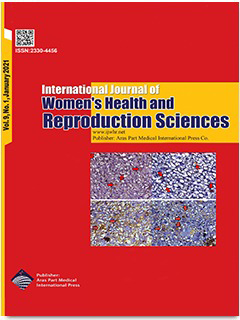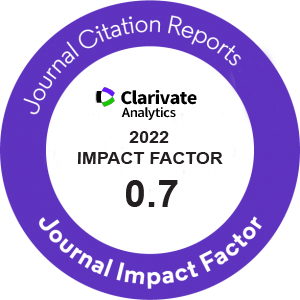| Original Article | |
| The Association Between Platelets/Lymphocyte Ratio and Premature Rupture of Membranes | |
| Seyedeh Hajar Sharami1, Gelareh Biazar2, Farnoush Farzi2, Zahra Atrkarroushan3, Mohadese Ahmadi2, Yasmin Chaibakhsh2, Mohammad Reza Habibi2, Mahsa Khosousi Sani1, Nazanin Hoseinzade Sanatkar4 | |
| 1Reproductive Health Research Center, Department of Obstetrics and Gynecology, Al-Zahra Hospital, School of Medicine, Guilan University of Medical Sciences, Rasht, Iran 2Anesthesiology Research Center, Department of Anesthesiology, Alzahra Hospital, Guilan University of Medical Sciences, Rasht, Iran 3Department of Statistic, Guilan University of Medical Sciences, Rasht, Iran 4Student Research Committee, Anesthesiology Research Center, Department of Anesthesiology, Alzahra Hospital, Guilan University of Medical Sciences, Rasht, Iran |
|
|
IJWHR 2021; 9: 080-083 DOI: 10.15296/ijwhr.2021.14 Viewed : 1599 times Downloaded : 3192 times. Keywords : Premature rupture of membranes, Association, Platelet-to-lymphocyte ratio |
|
| Full Text(PDF) | Related Articles | |
| Abstract | |
Objectives: Premature rupture of membrane (PROM) refers to the spontaneous rupture of fetal membranes prior to delivery and the initiation of the labor. In addition, the early rupture of membranes can lead to several adverse complications for both the mother and the fetus. Therefore, the present study aimed to investigate the association between the platelet-to-lymphocyte ratio (PLR) and the premature rupture of the membrane in pregnant women. Materials and Methods: This retrospective case-control study reviewed the files of 150 women with PROM matched with 150 spontaneous preterm labor (SPL) women at Al-Zahra hospital of Rasht during 2017-2018. Demographic data, complete blood cell count, PLR, maternal age, gestational week, gravida, parity, and birth weight were recorded, and finally, the obtained data were analyzed by SPSS, version 19. Results: Based on the results, there was a statistically significant difference between maternal platelet count and PLR in these two groups (P = 0.0001). However, no significant difference was observed regarding maternal age, gravida, parity, and maternal lymphocytes count in PROM and control groups (P > 0.05). According to logistic regression analysis, a negative association was found respecting gestational age and PLR in the PROM group while a positive association was observed in the group without PROM regarding birth weight and PRL. In the receiver-operator curve diagram, the appropriate cut-off point for the PLR index for detecting PROM was determined as 142.2 with a sensitivity of 62.7% and a specificity of 63.3%. Conclusions: In general, a significant association was found between PLR and PROM. Therefore, well-planned cohort studies are welcomed to find any prognostic role for this marker. |
Cite By, Google Scholar
Google Scholar
PubMed
Online Submission System
 IJWHR ENDNOTE ® Style
IJWHR ENDNOTE ® Style
 Tutorials
Tutorials
 Publication Charge
Women's Reproductive Health Research Center
About Journal
Publication Charge
Women's Reproductive Health Research Center
About Journal
Aras Part Medical International Press Editor-in-Chief
Arash Khaki
Mertihan Kurdoglu Deputy Editor
Zafer Akan























